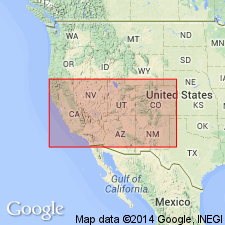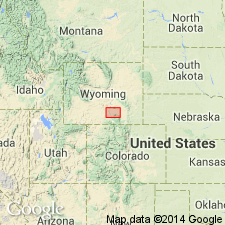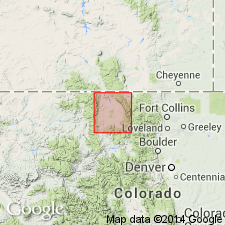
- Usage in publication:
-
- North Park
Summary:
Map 1 (Rocky Mountains). [North Park (Pliocene?) of northern Colorado, is shown as younger than Niobrara (Pliocene), White River (Miocene), and Vermillion Creek (Eocene, and is overlain by Quaternary.]
Source: US geologic names lexicon (USGS Bull. 896, p. 1514).

- Usage in publication:
-
- North Park formation*
- Modifications:
-
- Revised
- AAPG geologic province:
-
- Green River basin
Summary:
Pg. 246, columnar section of Cretaceous-Tertiary rocks of central Carbon Co., WY. North Park formation. White volcanic-ash beds, cherty bands; base conglomeratic. Thickness 4,500 feet. Unconformably overlies Fort Union formation, which consists of 1,200+/- feet of dark-colored shales and shaly sandstones, resting on "Upper Laramie." [Age is Tertiary (Miocene?).]
Source: US geologic names lexicon (USGS Bull. 896, p. 1514).

- Usage in publication:
-
- North Park formation*
- Modifications:
-
- Contact revised
- AAPG geologic province:
-
- North Park basin
Summary:
Lower contact revised in that North Park formation unconformably? overlies newly named Coalmont formation. Mapped (geologic map) as a long strip about 20 mi long and 1 to 5 mi wide on the North Park syncline in central part of North Park in Jackson Co, CO in the North Park basin. Is the youngest Tertiary unit mapped. The younger units on the map are the Quaternary moraines. Is 500 ft thick on west side of the syncline and 1,000 ft thick on east side. Made up of gray shale and sandstone, and is characterized by presence of volcanic material. Has several hard white calcareous sandstone and marly layers. Gray shale is like that in the Coalmont except that it contains pinkish and gray ashy streaks, and thin laminae of black cinder. Sandstone is usually fine grained but locally coarse grained. Conglomerate of rounded basalt pebbles is irregularly distributed. Thought to be younger than Eocene, though no fossils found in it. May have been laid down in a lake that extended to the North Platte valley of WY.
Source: GNU records (USGS DDS-6; Denver GNULEX).
For more information, please contact Nancy Stamm, Geologic Names Committee Secretary.
Asterisk (*) indicates published by U.S. Geological Survey authors.
"No current usage" (†) implies that a name has been abandoned or has fallen into disuse. Former usage and, if known, replacement name given in parentheses ( ).
Slash (/) indicates name conflicts with nomenclatural guidelines (CSN, 1933; ACSN, 1961, 1970; NACSN, 1983, 2005, 2021). May be explained within brackets ([ ]).

